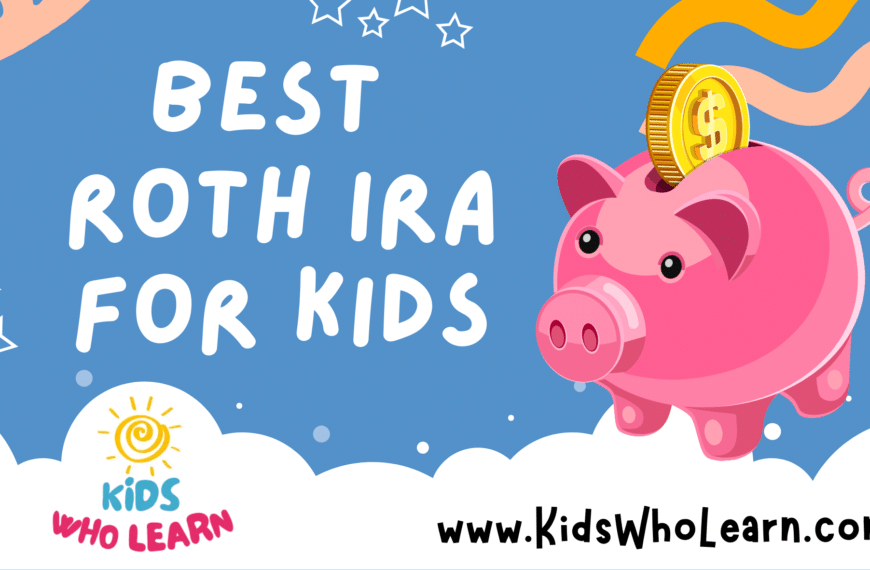Saving for your children’s future is an essential aspect of parenting that can influence their education, financial stability, and overall opportunities. As a parent or guardian, you’re tasked with making prudent decisions that can safeguard your kids’ financial security from an early age. Understanding the various savings options is the first step towards setting up a solid financial foundation for your children. There are numerous vehicles designed to facilitate your savings goals, ranging from traditional savings accounts to more complex investment options that offer potential for growth over time.
Planning and budgeting form the backbone of effective saving strategies. It’s important to establish a realistic plan that aligns with your family’s financial ability and your child’s future needs. Whether it’s for their education, a first car, a wedding, or simply to give them a financial headstart, identifying your target amount and timeframe can help you choose the right saving methods. Additionally, exploring educational funding strategies and understanding the influence of tax on your savings is essential for maximizing your investments.
Teaching your children about financial responsibility and literacy can also have a significant impact on their ability to manage and preserve wealth as they grow. By including them in the saving process and discussing financial milestones, you’re not only preparing them for the future financially but also equipping them with valuable life skills. As they transition into adulthood, they’ll benefit from the financial discipline and knowledge instilled at a young age.
Key Takeaways
- Choosing the right savings method is crucial for long-term financial security for your children.
- A realistic plan and understanding taxes can help maximize your savings potential.
- Financial literacy can empower children to responsibly manage their future wealth.
Understanding the Basics of Saving for Children
In managing your family’s finances, it’s crucial to grasp how to effectively save for your children’s future.
The Importance of Starting Early
By beginning to save early, you can take advantage of compound interest, allowing your contributions to grow more significantly over time. It’s a simple equation: the sooner you start, the more time your money has to grow. Start when your kids are young to instill a sense of financial responsibility in them, shaping healthy money habits that can last a lifetime.
Savings Account Fundamentals
Choosing the right savings account is one of the first steps in setting aside funds for your children. Look for accounts with higher interest rates and low fees to maximize your savings. Consider setting up an automatic transfer to the savings account to ensure consistent contributions. Make sure to review the terms and conditions of the account carefully to understand any access restrictions or educational benefits it may provide.
Types of Savings Accounts
Choosing the right type of savings account for your children can significantly impact their financial future. Factors such as interest rates, risk levels, and the purpose of the savings must be carefully considered.
Regular Savings Accounts
Regular Savings Accounts are a stable option for setting aside funds for your kids. They typically offer modest interest rates and are FDIC insured up to the maximum amount allowed by law, making them a safe choice for your family’s savings. Most banks and credit unions provide these accounts, providing easy access and a straightforward way to begin saving.
High-Yield Savings Accounts
High-Yield Savings Accounts, on the other hand, offer higher interest rates than regular savings accounts, allowing the money you save for your children to grow more quickly. These accounts are still backed by FDIC insurance, ensuring that your savings are protected. However, they may require higher minimum balances or limit transactions to maintain the higher rate.
Children’s Savings Accounts
Children’s Savings Accounts are specifically designed for young savers. They often come with no minimum balance requirements and provide an educational component to help your kids learn about banking and financial management. While the interest rates may vary, these accounts are a great tool to help children engage with saving from an early age and to instil a sense of financial responsibility.
Investment Options for Long-Term Growth
The following options epitomize strong avenues for cultivating your child’s financial future through the power of investing, earnings, and compound interest.
529 Plans
529 Plans are tax-advantaged savings plans specifically designed for future education costs. Your contributions grow tax-free, and withdrawals for qualified education expenses are also exempt from federal tax. Each state sponsors its own version of the 529 plan, and contribution limits can be quite high, often in excess of $300,000 per beneficiary. These plans can be an efficient way to save for your child’s college tuition, room, and board, and even K-12 tuition expenses in some cases.
- Tax Benefits: Earnings in a 529 plan are not subject to federal tax, and generally not subject to state tax when used for qualified education expenses.
- Investing: Broad range of investment options such as mutual funds and ETFs.
- Compound Interest: The potential for growth is substantial due to being invested over a long period.
Custodial Accounts
A Custodial Account under the Uniform Gifts to Minors Act (UGMA) or the Uniform Transfers to Minors Act (UTMA) allows you to invest in assets like stocks, bonds, and mutual funds for your child’s benefit. The assets are managed on your child’s behalf until they reach the age of majority. Custodial accounts offer flexibility as the funds can be used for any purpose benefiting the child, not just education.
- Tax Benefits: The child’s tax rate applies to earnings, often resulting in lower taxes.
- Investing: Can hold a variety of investment products.
- Contribution Limits: No contribution limits, but watch out for gift tax implications above $15,000 per year.
Roth IRAs for Minors
If your child has earned income, you can open a Roth IRA in their name. While contributions are made with after-tax dollars and there’s no immediate tax benefit, the account offers substantial long-term advantages. Contributions can be withdrawn tax-free at any time, and earnings can be withdrawn tax- and penalty-free once the account has been open for five years and the child reaches 59½ years of age.
- Tax Benefits: Tax-free growth and qualified withdrawals.
- Investing: Opportunity to invest in stocks, bonds, mutual funds, and more.
- Contribution Limits: Up to the lesser of the child’s earnings or $6,000 (for 2023).
- Compound Interest: The earlier a Roth IRA is started, the more potential for earnings to grow through compound interest.
Your choice among these vehicles will depend on your financial goals for your child, whether that’s higher education, a head start on retirement savings, or financial support for early adulthood.
Budgeting and Planning
To secure your child’s financial future, precise budgeting and goal-setting are indispensable. This tactic ensures that saving for educational expenses and other aspirations becomes a manageable part of your fiscal routine.
Setting Financial Goals
Start by outlining specific financial targets for your child’s education and other needs. Factor in college costs which are rising steadily, with four-year institutions charging an average of $26,820 for state residents at public colleges and $54,880 at private colleges annually. Setting milestones for savings can help you stay on track.
- By age 5: Aim to save $25,000 for future educational expenses.
- By age 10: Target a goal of $50,000 to cover tuition and related costs.
Creating a Budget for Your Child’s Future
Draft a monthly budget that earmarks funds for your child’s savings. Include categories for an allowance to teach them about money management early on.
- Income: Document your monthly household income.
- Expenses: List your recurring monthly expenses to gauge how much you can regularly save.
- Savings for Child: Decide on a set percentage of your income to save for your child’s future.
Consider opening a debit card under your child’s name linked to the savings to track expenses and teach financial responsibility. Use these tools to ensure your child learns the importance of money management alongside your saving efforts.
Educational Funding Strategies
To secure your child’s educational future, it’s crucial to understand the differences between various funding strategies. Selecting the right plan can lead to significant savings on qualified education expenses.
Prepaid Tuition Plans
Prepaid Tuition Plans allow you to pay for your child’s future tuition at today’s rates, thereby avoiding the risk of tuition inflation. With these plans, you’re purchasing units or credits at participating colleges and universities for future tuition and mandatory fees.
- Eligibility: Varies by state and plan.
- Tax Benefits: Earnings are not subject to federal tax if used for qualified education expenses.
Coverdell ESAs
A Coverdell Education Savings Account (ESA) is a tax-advantaged investment account designed to encourage savings for education expenses. You can contribute up to $2,000 per year for each beneficiary.
- Use: Funds can be used for elementary, secondary, and higher education expenses.
- Income Restrictions: Contribution limits may apply based on modified adjusted gross income.
Scholarships and Financial Aid
Scholarships and Financial Aid are vital sources of funding that can reduce the overall cost of education. They are awarded based on merit, need, or a combination of both.
- Scholarships: Usually do not have to be repaid and can be found through schools, private organizations, and community groups.
- Financial Aid: It may include grants, loans, and work-study programs. Start with the Free Application for Federal Student Aid (FAFSA) to assess eligibility.
Maximizing these funding strategies can greatly assist in managing your child’s educational expenses in a financially efficient manner.
Maximizing Tax Advantages
When saving for your children’s future, understanding and utilizing tax advantages is crucial. These strategies can help grow investments more significantly over time.
Utilizing Tax-Deferred Accounts
You can take advantage of tax-deferred accounts like 529 plans, which are designed to foster savings for future education costs. Earnings in a 529 plan grow federally tax-free, and withdrawals for qualified education expenses are also tax-free. It’s important to note that individual states may offer additional tax benefits such as deductions or credits for contributions to a 529.
- Federal Benefit: Tax-free earnings growth
- Withdrawal Benefit: Tax-free for qualified education
With custodial accounts, such as an UGMA/UTMA, the assets are managed on behalf of the child until they reach legal age. While not tax-free, they offer some tax benefits through the child’s tax rate:
- First $1,100 in unearned income typically tax-free (for a child under 19 or a full-time student under 24)
- Next $1,100 taxed at the child’s tax rate
- Beyond $2,200 taxed at the parents’ tax rate
Understanding Gift Tax Exclusions
Gift tax exclusions can be used effectively when saving for your kids. As of my last update in 2023, you can give up to $16,000 per year to any individual without it counting against the lifetime gift and estate tax exclusion.
Annual Exclusion Amount (Per Donee): $16,000
Strategic gifting using this exclusion can help in transferring wealth to your children’s accounts without incurring additional taxes. By doing so, you also reduce the size of your estate, which might be beneficial for estate tax purposes down the line. When gifting to a 529 plan, you can even exercise a special rule that allows you to make a lump-sum contribution of up to five times the annual exclusion, spreading it over five years for tax purposes.
Teaching Financial Literacy and Responsibility
Instilling financial literacy and responsibility in your children lays the foundation for their future financial well-being. By incorporating practical experience like an allowance into their routine, you can encourage money management skills from a young age.
Allowance as a Tool for Education
Allowance can be a valuable educational instrument that introduces your children to basic financial concepts. When you offer your child an allowance, it establishes a sense of trust and provides a framework within which they can make their own financial decisions.
- Set clear guidelines on how the allowance should be earned and used.
- Encourage saving by introducing tools such as a piggy bank or a savings account.
Encouraging Money Management from a Young Age
Starting money management lessons early can equip your child with the skills they need to navigate their financial future independently.
- Teach them to set financial goals and allocate their allowance accordingly.
- Help them understand the value of money by correlating work with earnings.
By focusing on these aspects of financial education, you provide your child with the knowledge needed to make informed monetary decisions throughout their lives.
Special Considerations
When planning to save for your children, it’s crucial to consider how to shield those savings from potential creditors and to address the unique needs of children with disabilities.
Protecting Savings from Creditors
To ensure that your savings for your child are not vulnerable to creditors, it’s essential to choose a saving place wisely. Consider setting up a trust. A trust can offer a legal barrier against creditors, as the funds are no longer in your direct control and therefore not as easily accessible for claims. Another option is to contribute to an education savings account, like a 529 Plan, which in many cases are protected from creditors.
Example of creditor protection with a 529 Plan:
| Your Contribution | Protection Level (Varies by State) |
|---|---|
| Initial Contribution | Fully protected in some states |
| Ongoing Contributions | May have a cap on protected amount |
Saving for Children with Disabilities
For children with disabilities, an ABLE account offers a specialized savings option without affecting eligibility for government benefits like SSI or Medicaid, which have asset limits. Up to $15,000 per year (as of 2021) can be contributed and used for qualified expenses that enhance the child’s quality of life.
- ABLE Account Benefits:
- Tax-Advantaged: Earnings grow tax-free if used for qualified expenses.
- Control: You can manage the account and determine the best use of funds.
- Flexibility: Funds can cover a wide array of disability-related expenses.
Remember, also maintaining an emergency fund separate from the savings for your child can prevent the need to withdraw from these protected sources during unexpected financial situations.
Additional Financial Products and Services
Exploring additional financial products and services can provide diverse ways to save and manage money for your child’s future. From digital banking solutions to investment accounts geared toward minors, these options offer a range of benefits and learning opportunities.
Banking and Mobile Apps
Most banks offer youth savings accounts which often come with lower fees and are designed to teach children about personal finance. Additionally, various mobile apps are tailored to provide a user-friendly experience for both you and your child, allowing you to monitor savings progress and set financial goals together.
- Youth Savings Accounts: Typically offer no or low monthly fees and sometimes a higher interest rate to encourage saving.
- Mobile Apps: Provide tools such as savings trackers, educational content, and parental controls.
Brokerage Accounts for Children
Opening a brokerage account for your child can introduce them to the world of investing. Some brokerage firms offer custodial accounts like the UTMA/UGMA, which can hold investments until your child reaches adulthood, while others have special accounts for children where they can learn to invest with your supervision.
- UTMA/UGMA Accounts: Investment accounts that transfer to the child when they reach the age of majority.
- Special Children’s Investment Accounts: Allow children to make supervised investment decisions.
Credit Cards and Debit Cards for Minors
While minors generally cannot hold a credit card in their name until they are 18, you can add your child as an authorized user on your credit card to help build their credit early. Additionally, specially designed debit cards for minors are linked to their savings account and can help teach responsible spending.
- Authorized User on Credit Card: Helps build credit history; use with caution and set clear spending limits.
- Debit Cards for Minors: Often come with parental controls and real-time tracking of spending.
Transition to Adulthood: Financial Milestones
As your children approach adulthood, it’s essential to prepare them for the financial responsibilities they’ll face. This section focuses on the transition from savings strategies during their minor years to managing earnings, navigating college expenses, and even considering retirement savings.
From Savings to Earnings
When you turn 18, your earnings potential expands significantly as you’re legally able to work full-time. Create a budget to manage your expenses and understand the importance of living within your means. Acquire a job that provides a steady source of income and offers opportunities for growth. Utilize employer-sponsored financial education resources, when available, to make informed decisions about your money.
- First Job: Prepare a resume and gain employment.
- Budgeting: Track income and expenses routinely.
College Expenses and Student Loans
College often coincides with the transition to adulthood. If you’re managing college expenses, explore scholarships and grants that do not require repayment. Understand the terms and implications of student loans, if they are necessary. Choose a loan plan with a low interest rate and favorable repayment terms. Maintain communication with your loan servicer and remain informed about your remaining balance and payment schedules.
| Action | Purpose |
|---|---|
| Apply for scholarships | Reduce education costs |
| Secure student loans | Finance necessary tuition |
Retirement Savings and Family Support
Even in early adulthood, it’s prudent to plan for your long-term financial health. If possible, take advantage of any retirement savings plans, such as a 401(k) through your employer, especially if they offer matching contributions. As an adult child, you may also find yourself in a position to support family members. Establish clear boundaries and a plan for how much financial support you can realistically offer.
- Retirement Savings: Contribute early to compound interest benefits.
- Family Support: Define financial limits and communicate openly.
Remember, achieving these milestones will not only help secure your financial future but also set an example for responsible money management.
Closing Thoughts: Prioritizing Your Child’s Financial Future
Securing your child’s financial future requires a measured and proactive approach. Prioritize your child’s long-term financial needs by setting clear goals and making informed decisions. Create a plan that includes both short-term and long-term savings strategies.
- Automatic Savings: Set up automatic transfers to a dedicated savings account for your child. This ensures consistent savings and reduces the temptation to spend the money elsewhere.
Consider an Education Savings Account (ESA) for tax-efficient savings that can greatly assist with future educational expenses. This targeted account can be a pivotal step in managing the rising costs of education.
- Budgeting for Contributions: Allocate a portion of your monthly budget to contribute to your child’s savings. Even small, regular contributions can grow over time due to compound interest.
Review and adjust your savings plan annually to align with any changes in your financial situation or your child’s needs. Remember, consistency and a proactive stance are vital when planning for your child’s financial stability and success.
Frequently Asked Questions
These are common inquiries parents have when looking to set up financial savings for their children’s future.
What are the advantages of opening a custodial savings account for a child?
Opening a custodial savings account allows you to save money for your child’s future while the account remains under your control until they reach adulthood. The earnings are taxed at the child’s lower tax rate, and the funds can be used for a variety of expenses like education or a first car.
How can parents effectively contribute to a child’s Roth IRA?
Parents can contribute to a child’s Roth IRA as long as the child has earned income. The contributions are capped at the child’s annual earnings or the current year’s limit, whichever is less. It teaches the child about investments while growing tax-free retirement savings for them.
What is the ideal amount to save monthly for a child’s future expenses?
There is no one-size-fits-all answer. You should consider your financial goals for the child’s future, current income, and expenses. A common approach is to save between $25 and $100 monthly per child, increasing the amount as your income allows.
How can a 529 college savings plan benefit a child’s education funding?
A 529 plan is a tax-advantaged savings plan designed to encourage saving for future education costs. Contributions grow tax-deferred, and withdrawals for qualified education expenses are tax-free. This plan can also be used by family members and friends to contribute towards the child’s education savings.
What strategies can help an 11-year-old learn about and start saving money?
Encourage an 11-year-old to save money by setting goals and providing a small allowance. Open a savings account in their name, help them understand interest, and match their savings to incentivize them. Discussing financial literacy in age-appropriate terms fosters good money habits early on.
How can parents build wealth for their children over the long term?
Consistent investment in a diversified portfolio can help build wealth for children over the long term. Consider setting up automatic transfers to investment accounts designed for long-term growth, such as trust funds or index funds. Teaching children about financial management is also crucial for maintaining wealth as they grow.












